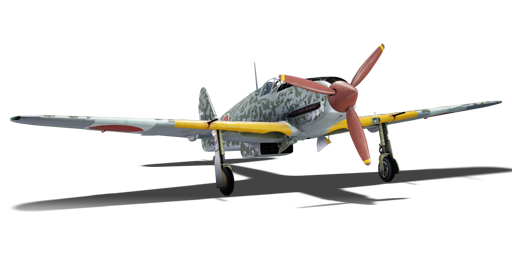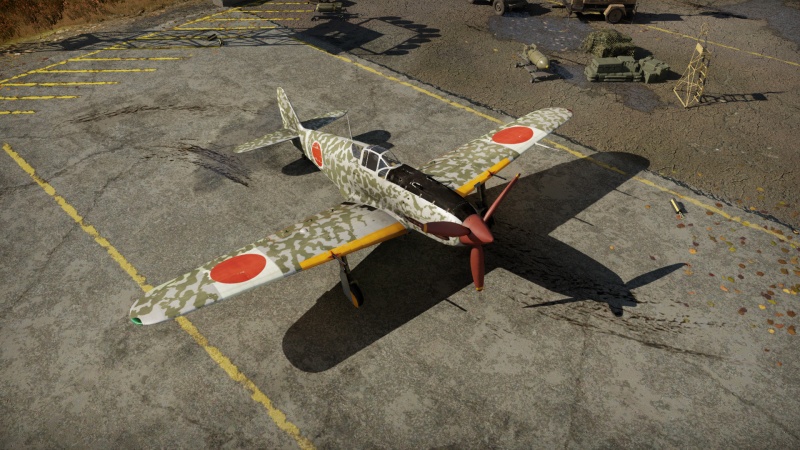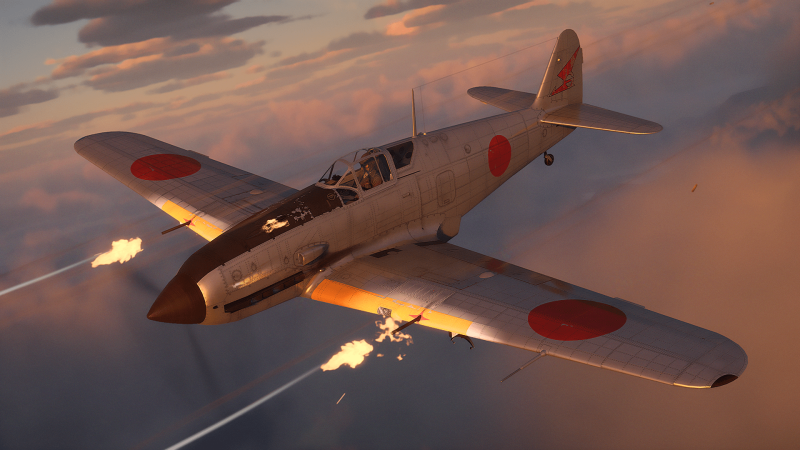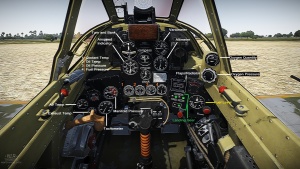Ki-61-I hei
| This page is about the Japanese fighter Ki-61-I hei. For other versions, see Ki-61 (Family). |
Contents
Description
The Ki-61-I hei Hien is a rank IV Japanese fighter with a battle rating of 5.3 (AB), 4.7 (RB), and 4.0 (SB). It has been in the game since the start of the Open Beta Test prior to Update 1.27.
The "Hei" modification of the Ki-61 still retains the above average manoeuvrability, common to the Japanese aviation tree. However, the Hei Hien has some faults - its top speed is only 20 km/h higher than that of the early "Zeroes". Its climb rate is enough for its role, and it retains energy fairly well. While its acceleration holds itself pretty well, Its top speeds are not on par with other aircraft making it similar to the German Bf 109 G-6. Its guns are also a hit and miss - it is equipped with the deadly MG 151 20 mm cannons, and it can also equip German belts with Minengeschoß shells. However, the Japanese 12.7s are lower velocity and a bit on the weak side. The Hien's ammo count is average, albeit not as much as American aircraft. One thing to be noted is that the landing flaps are very effective and will slow you down even if you use WEP. That said, use them when you are trying to make somebody on your six overshoot you.
The Hei Hien's armament is flexible, as it is able to equip multiple kinds of bombs. With accuracy and shot placement, the large ammunition pool can work to your advantage. Equipping the air targets belt for the MG 151 cannons is the best choice for air combat. It features a high degree of Minengeschoß shells, specially made German HE shells with thin walls. There is no 20 mm cannon shell in the game with more high explosive than the Minengeschoß. As for the 12.7s, Stealth or Air target belts are your best bet. The best choice of bomb loadout is the 250 kg bombs due to the lack of precision needed. A pilot can miss a direct hit on a pillbox and still destroy it.
General info
Flight performance
| Characteristics | Max Speed (km/h at 6,000 m) |
Max altitude (metres) |
Turn time (seconds) |
Rate of climb (metres/second) |
Take-off run (metres) | |||
|---|---|---|---|---|---|---|---|---|
| AB | RB | AB | RB | AB | RB | |||
| Stock | 572 | 556 | 10300 | 21.9 | 22.5 | 7.1 | 7.1 | 380 |
| Upgraded | 613 | 591 | 20.3 | 21.0 | 13.7 | 10.0 | ||
Details
| Features | ||||
|---|---|---|---|---|
| Combat flaps | Take-off flaps | Landing flaps | Air brakes | Arrestor gear |
| ✓ | ✓ | ✓ | X | X |
| Limits | ||||||
|---|---|---|---|---|---|---|
| Wings (km/h) | Gear (km/h) | Flaps (km/h) | Max Static G | |||
| Combat | Take-off | Landing | + | - | ||
| 850 | 250 | 292 | 282 | 230 | ~11 | ~8 |
| Optimal velocities (km/h) | |||
|---|---|---|---|
| Ailerons | Rudder | Elevators | Radiator |
| < 360 | < 350 | < 460 | > 312 |
Survivability and armour
- 13 mm Steel plate behind the pilot
Modifications and economy
Unlocking the "Offensive 20 mm" module should be a Hien pilot's first concern. The stock MG 151 belts aren't very good in a general sense, but the "Air targets" belt is. The "New 12.7 mm MGs" and "New 20 mm cannons" modules can also be helpful as they allow for longer periods of firing. Unlocking the bomb modules can help on most maps, no matter the game mode. Destroying some extra ground units can't hurt a team's victory chances. After researching the 20 mm belts try to unlock the performance modules.
Armaments
Offensive armament
The Ki-61-I hei is armed with:
- 2 x 20 mm MG 151 cannons, wing-mounted (150 rpg = 300 total)
- 2 x 12.7 mm Ho-103 machine guns, nose-mounted (400 rpg = 800 total)
Suspended armament
The Ki-61-I hei can be outfitted with the following ordnance:
- Without load
- 2 x 50 kg Army Type 94 GPHE bombs (100 kg total)
- 2 x 100 kg Army Type 94 GPHE bombs (200 kg total)
- 2 x 250 kg Army Type 92 GPHE bombs (500 kg total)
Usage in battles
Realistic battles
Instead of simply turn fighting the Ki-61 is very good at energy fighting, or "boom and zoom". Once at a high altitude the Hien pilot may choose to dive lower to attack an enemy. If the enemy is not destroyed on the first pass, it is recommended to climb sharply and gain altitude. By doing this, the Hien sets itself up for another attack while not being in the range of the enemy's guns.
The Hei Hien is best utilised as a multi-purpose fighter. Although proficient at energy fighting, the Ki-61 is also generally good at standard manoeuvres. It may lose turn fights with some enemy aircraft like the Spitfire Mk Vb/trop, but nonetheless it can still be used in multiple roles. The Hien is your standard "jack of all trades". It's not incredibly good at anything it does but is instead even across the board. This allows the Hien pilot to choose what role he or she wants to play in the battle. One could play the reserved, high flying energy fighter, or the aggressive low flying dogfighter. The Ki-61 allows these choices.
If caught in a sticky situation, the Hien pilot may choose to do several things. Depending on your altitude, executing rolling scissors or an overshoot may be a valid tactic. Try to make the enemy pilot feel pressured to disengage. Depending on the enemy's aircraft, use your speed to your advantage and try to get away. The surest tactic would be communicating with teammates to ensure your assailant's death. Once tailed, the Hien pilot can "set up" an enemy by nosing up about 70 degrees so the entirety of the enemy plane is shown. At this stage, ideally, your teammate is arriving to save the day. In Realistic battles, if your team is made up of A6Ms it may also be beneficial to fly to them and start turn fighting.
Simulator battles
In Sim, the Ki-61 can be used in BnZ fighting, turn fighting, intercepting and some ground pounding. The Ki-61 is overall a pretty friendly plane to fly. It is quite fast, handles nicely at all speeds, has decent visibility especially over the nose, climbs great and has powerful armament. However its main disadvantage is the weak protection.
Before taking off, bring at least 30 minutes of fuel for longer patrol time. If you are not using MEC, use around 95% throttle when cruising below 3,000 m since the engine will slowly heat up at full throttle. But full throttle is fine at higher altitudes.
Only elevator trim is available, so when the stick is at its deadzone, the Ki-61 will roll and yaw to the left side. Therefore you always need to pull the stick to the right which can get a bit annoying. Usually, a trim of around -7% is enough. But when carrying the 2 x 250 kg bombload, no negative trim is needed.
For dogfighting, it is always safer to engage with an altitude advantage. Most dogfights in sim happen below 3,000 m so the Ki-61 can easily climb up to that altitude. As mentioned in the description, its climb rate is actually great, don't get misled by the stat card. Once at an advantageous height, boom & zoom the enemies. The Ki-61 can easily accelerate to more than 550 km/h in a dive which is decently fast but requires more precise manoeuvres to get the correct lead, since the faster you go the smaller the shooting window is. A successful pass will usually cripple the enemy due to the destructive twin MG 151 cannons. Aside from BnZ, the Ki-61 is also excellent at turn fighting - with the appropriate opponent, of course. Except a few dedicated turn fighters, the Ki-61 can out-turn and get on most opponents' tail with combat flaps deployed. Note: do not turn with Spitfires or Zeros, you will never out-turn them. If you see a plane with a streamlined inline engine and large, elliptical wings (Spitfire) or something with rounded wingtips and stabiliser tips, a radial engine and a pointy tail (A6M), try some defensive manoeuvres like barrel rolls or disengage by diving towards a nearby friendly airfield. Note that the Ki-61's roll rate is very average so avoid manoeuvres like scissors.
When intercepting planes, it is crucial to know what the target is, because although you have powerful armament, most targets can still easily damage you in return. If it is a bomber/attacker with decent defensive firepower or great turret coverage then you might want to disengage after some attempts if you don't want to die. From the hard-hitting M2 Browning to the fast-firing MG 15, any gun can critically damage the Ki-61 especially on the engine, fuel tanks, and pilot which can always lead to a later crash. Before attacking try to get an altitude advantage and perform deflection shots. To maximise the damage it is better to aim for their wings and engines, as the fuselage usually soaks up quite some bullets. Only fire when the bomber passes in front of your guns. This short window might seem inadequate to do anything, but the 20 mm Mineshells will not disappoint. A few hits with the MG 151 is enough to cripple the target. But DO NOT follow behind a bomber's 6 unless you are sure that its tail gunners are unconscious. Chasing behind a bomber makes yourself pretty much stationary for the tail gunners, and you will be showered with bullets.
For ground pounding, the best loadout is the 2 x 250 kg bombs. With an extra 500 kg of weight attached outside, the Ki-61 handles much clumsier during take offs, especially on the roll axis. Longer distance is needed before lifting off. Dive at a shallow angle to approach the target, try to get as close as possible but avoid crashing into the ground. When the target fills up about 1/3 in the gunsight and the gunsight slices just above the target, drop the bombs and immediately pull up. It is best to set separate keybinds for firing MG and cannons as wasting precious cannon rounds can be fatal. The 2 MGs perform well in killing trucks, AA guns and artilleries as they have plenty of ammo. However, constantly watch your surrounding, especially your high 6 for any incoming enemies.
Enemies worth noting:
- Me 264: This giant is one of the few bombers who get air spawns in Sim, so it usually flies higher than you think. On top of this, the Me 264 is armed with large calibre MG and cannons all over it, therefore tailing a 264 is basically suicide unless all of their gunners are knocked out. You can treat the 264 almost like a B-29 or B-17 as they are very similar in both design and defensive capabilities. It is best to head-on the 264 if you can as you can easily knock out the pilots due to its glazed nose while also taking minimal damage. However the bomber lacks a ventral turret on its belly, making it easy to deal damage from below, but be wary of the downwards facing rear 20 mm cannon near the tail. The safest way to attack is from a higher altitude, dive at an oblique angle and focus fire on the wings and nose. Never engage if you have no altitude advantage.
- B-25, Ju 88, IL-2, etc: These aircraft have either powerful defensive guns, for example the B-25, or wide gun coverage such as the Ju 88. The most threatening one, the B-25, is fairly easy to distinguish. It has a short and wide fuselage, twin radial engine hanging under the wings and a H-tail. Focus your fire on the engines and constantly swing sideways to avoid getting hit. A few hits from the M2 Browning is a guaranteed death. The Ju 88, on the other hand, has great underside gun coverage so attacking from below isn't a very good option. Try engaging from the sides and concentrate the fire on the front half of it, as that is where all the vital components are located. Again, never engage any of these if you have no altitude advantage. Pin them on the map and leave them to teammates with more powerful firepower.
- A6M, Spitfire, etc: If you see them on your tail try outrunning them by diving at around -40 degrees. The Ki-61 still remains responsive handling at 600 km/h, but its speed retention is not the best, meaning it will start to lose speed quickly and the enemy might catch up. If you are near a friendly airfield, great. If not, then hope for the best and run towards the friendly side. Don't forget to pitch up and down a little to mess up their aim, the early Spitfires and A6M only have a 60-round drum per cannon which will run out fairly fast. The leftover 7.7 mm machine guns will not be as destructive.
Manual Engine Control
| MEC elements | ||||||
|---|---|---|---|---|---|---|
| Mixer | Pitch | Radiator | Supercharger | Turbocharger | ||
| Oil | Water | Type | ||||
| Not controllable | Controllable Not auto controlled |
Controllable Not auto controlled |
Controllable Not auto controlled |
Separate | Not controllable 1 gear |
Not controllable |
Pros and cons
Pros:
- Generally performs well in the most common tactics, both BnZ and turn-fighting, allowing flexible gameplay depending on the situation
- Outstanding climb rate means good energy retention
- Has decent dive speed, can easily out-dive slower opponents
- Great firepower thanks to the pair of 20 mm MG 151 and the minengeschoss rounds
- Large amount of ammunition for the 12.7 mm (400 rpg) is great for long battles
- Some armour protection for the pilot means that it will not easily get pilot-sniped by small-calibre/low-penetrating guns from the back
- Able to equip up to 2 x 250 kg bombs, meaning it is also useful in ground pounding/tank RB
- Adequate over-the-nose visibility allows easier leading in Simulator
Cons:
- Average backwards visibility can be lethal in simulator
- Locks up at high speeds
- The MG 151 has only 150 rpg which requires strict trigger control
- No frontal armour, can be fatal in a head-on
- Average roll rate which worsens as speed increases, can easily get out-rolled by Fw 190s and I-16s
- Repair costs are very high (AB/SB)
History
The Ki-61 was first put into service in with a special training unit, the 23rd Chutai, and entered combat for first time in early 1943, during the New Guinea campaign. The Hiens were sent into a difficult theatre where jungles and adverse weather conditions coupled with a lack of spare parts quickly made short work of the Japanese fighters. Nonetheless, the Hien proved to be a worthy adversary and it even outclassed the P-40. Towards the end of the war, Ki-61s were relied upon heavily to defend the Japanese mainland from B-29 attacks. Some pilots used ramming attacks to down the Superfortresses. Soon, entire "special attack squadrons" were formed for the sole purpose of ramming B-29s.
The Ki-61-I hei model utilised imported German Mauser 20 mm MG 151 cannons, placed in the wings. 800 of these weapons along with ammunition were sent to Japan via submarine in August of 1943.
| Archive of the in-game description | |
|---|---|
|
A lightweight multipurpose fighter plane, the Ki-61 Hien ("Swallow") was well-armed and well-armoured. From the very beginning, the makers of the Ki-61 concerned themselves with protecting the fuel tanks and the pilot. The light multipurpose fighter was an effective answer to "hit-and-run" fighters, thanks to its survivability and high diving speed. The Ki-61 had a Kawasaki Ha-40 liquid-cooled inverted V12 engine, a licensed copy of the DB 601A, capable of 1,175 hp. A prototype was ready in 1941, and by the next year the first production models were manufactured and the Ki-61 entered service. To strengthen armament in the Ki-61-I, instead wing-mounted machine guns of the previous models Ki-61-1-Co and -Otsu was established by German's 20-mm cannons MG 151/20, which in the amount of 800 units in august 1943 were taken to Japan by submarines. All in all, 3,078 Ki-61 fighters (of various types) were produced. | |
Media
- Skins
See also
Links to the articles on the War Thunder Wiki that you think will be useful for the reader, for example:
- reference to the series of the aircraft;
- links to approximate analogues of other nations and research trees.
External links
| Kawasaki Aircraft Industries (川崎航空機工業株式会社) | |
|---|---|
| Biplane Fighters | Ki-10-I · Ki-10-I C · Ki-10-II · Ki-10-II C |
| Fighters | Ki-61-I ko · Ki-61-I otsu · Ki-61-I hei · Tada's Ki-61-I hei · Ki-61-I tei · Ki-61-II Otsu Kai |
| Ki-100 · Ki-100-II | |
| Interceptors | Ki-45 ko · Ki-45 otsu · Ki-45 hei · Ki-45 tei |
| Ki-96 | |
| Ki-102 otsu | |
| Ki-108 Kai | |
| Bombers | Ki-32 |
| Ki-48-II otsu | |
| Captured | ␗Ki-45 hei/tei · ␗Ki-61-I otsu · ▃Ki-61-Ib |
| See also | Kawasaki Shipyard Co. |
| Japan fighters | |
|---|---|
| Navy | |
| Carrier-based fighter | |
| A5M | A5M4 · Hagiri's A5M4 |
| A6M | A6M2 mod. 11 · A6M2 · A6M3 · A6M3 mod. 22 · A6M3 mod. 22Ko · A6M5 · A6M5 Ko · A6M5 otsu · A6M5 Hei · A6M6c |
| A7He | A7He1* |
| A7M | A7M1 (NK9H) · A7M2 |
| Land-based Fighter | |
| J2M | J2M2 · J2M3 · J2M4 Kai · J2M5 · J2M5 (30 mm) |
| J6K | J6K1 |
| J7W | J7W1 |
| N1K-J | N1K1-Ja · N1K2-J · N1K2-Ja |
| Fighter seaplane | |
| N1K | N1K1 |
| A6M-N | A6M2-N |
| Army | |
| Ki-10 | Ki-10-I · Ki-10-I C · Ki-10-II · Ki-10-II C |
| Ki-27 | Ki-27 otsu · Ki-27 otsu Tachiarai |
| Ki-43 | Ki-43-I · Ki-43-II · Ki-43-III otsu |
| Ki-44 | Ki-44-I · Ki-44-I 34 · Ki-44-II otsu · Ki-44-II hei |
| Ki-61 | Ki-61-I ko · Ki-61-I otsu · Ki-61-I hei · Tada's Ki-61-I hei · Ki-61-I tei · Ki-61-II Otsu Kai |
| Ki-84 | Ki-84 ko · Ki-84 otsu · Ki-84 hei |
| Ki-87 | Ki-87 |
| Ki-94 | Ki-94-II |
| Ki-100 | Ki-100 · Ki-100-II |
| Other countries | ▅F4U-1A · ▅P-51C-11-NT · ▅Bf 109 E-7 · ▅Fw 190 A-5 |
| *Imported designation of the He 112 (A6M was in development - A7M would take A7 designation after the cancelation of the A7He) | |







